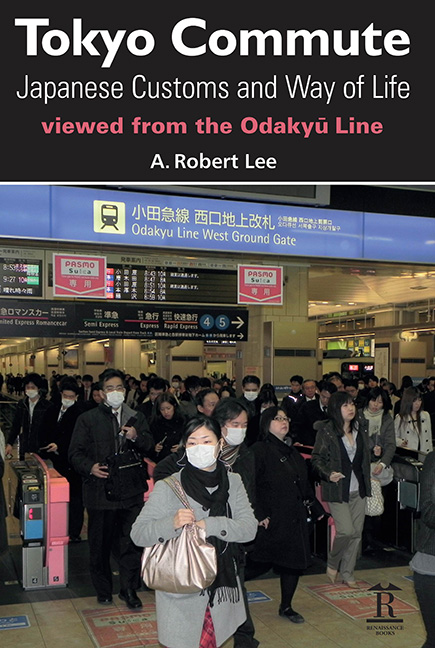Book contents
- Frontmatter
- Dedication
- Acknowledgements
- Contents
- 1 Odakyū-sen
- 2 Shinjuku Station
- 3 Shinjuku
- 4 Mukōgaoka-yūen North
- 5 Mukōgaoka-yūen South
- 6 Mukōgaoka-yūen Platform
- 7 January Monday
- 8 Odakyū Notables
- 9 Odakyū Line Sounds Familiar
- 10 Train Notices
- 11 Odakyū Commercials
- 12 February Tuesday
- 13 Odakyū Keitaispracht
- 14 By-line, Setagaya Line
- 15 March Wednesday
- 16 Odakyū Day-out Sendagi
- 17 Shimo-Kitazawa
- 18 Bicycle!
- 19 Odakyū Bike Interview – Toda-san
- 20 International Interlude via Narita Airport
- 21 Keitai Train Culture
- 22 April Thursday
- 23 Odakyū Tamagawa
- 24 Station Sights
- 25 Odakyū-sen, Yoyogi-Hachiman Eki
- 26 May Friday
- 27 Mukoōgaoka-yūen, Day for Night
- 28 Odakyū Day-out, Hakone
- 29 June Saturday
- 30 Odakyū Commercials
- 31 Odakyū Smokes
- 32 By-line, Nambu Line
- 33 Odakyū Bag Watch
- 34 Seijo Times
- 35 Odakyū Day-out, Yokohama
- 36 July Sunday
- 37 Odakyū Trains of Thought
- 38 Train Signs, Train Sounds
- 39 By-line, Tama Express
- 40 August Monday
- 41 Odakyū Day-out, Chiba
- 42 September Tuesday
- 43 Odakyū Lady-grooming
- 44 Odakyū and Near-Odakyū Women’s Hairday
- 45 Odakyū Evenings-out
- 46 October Wednesday
- 47 Odakyū Day-out, Ibaraki
- 48 Chikan! Odakyū Misbehaviour
- 49 November Thursday
- 50 Odakyū Blues
- 51 Odakyū Men’s Haircut
- 52 Odakyū Day-out, Ō-Sumo
- 53 December Friday
- 54 Odakyū Store
- 55 Odakyū Bookshelf
- 56 Last Train
- Glossary
35 - Odakyū Day-out, Yokohama
Published online by Cambridge University Press: 26 May 2022
- Frontmatter
- Dedication
- Acknowledgements
- Contents
- 1 Odakyū-sen
- 2 Shinjuku Station
- 3 Shinjuku
- 4 Mukōgaoka-yūen North
- 5 Mukōgaoka-yūen South
- 6 Mukōgaoka-yūen Platform
- 7 January Monday
- 8 Odakyū Notables
- 9 Odakyū Line Sounds Familiar
- 10 Train Notices
- 11 Odakyū Commercials
- 12 February Tuesday
- 13 Odakyū Keitaispracht
- 14 By-line, Setagaya Line
- 15 March Wednesday
- 16 Odakyū Day-out Sendagi
- 17 Shimo-Kitazawa
- 18 Bicycle!
- 19 Odakyū Bike Interview – Toda-san
- 20 International Interlude via Narita Airport
- 21 Keitai Train Culture
- 22 April Thursday
- 23 Odakyū Tamagawa
- 24 Station Sights
- 25 Odakyū-sen, Yoyogi-Hachiman Eki
- 26 May Friday
- 27 Mukoōgaoka-yūen, Day for Night
- 28 Odakyū Day-out, Hakone
- 29 June Saturday
- 30 Odakyū Commercials
- 31 Odakyū Smokes
- 32 By-line, Nambu Line
- 33 Odakyū Bag Watch
- 34 Seijo Times
- 35 Odakyū Day-out, Yokohama
- 36 July Sunday
- 37 Odakyū Trains of Thought
- 38 Train Signs, Train Sounds
- 39 By-line, Tama Express
- 40 August Monday
- 41 Odakyū Day-out, Chiba
- 42 September Tuesday
- 43 Odakyū Lady-grooming
- 44 Odakyū and Near-Odakyū Women’s Hairday
- 45 Odakyū Evenings-out
- 46 October Wednesday
- 47 Odakyū Day-out, Ibaraki
- 48 Chikan! Odakyū Misbehaviour
- 49 November Thursday
- 50 Odakyū Blues
- 51 Odakyū Men’s Haircut
- 52 Odakyū Day-out, Ō-Sumo
- 53 December Friday
- 54 Odakyū Store
- 55 Odakyū Bookshelf
- 56 Last Train
- Glossary
Summary
JAPANESE YOKOHAMA
It is the Odakyū first to Machida, and from there via the Yokohama Line, to Ishikawachō Station. Best foot forward for five to ten minutes to the waterfront and Yamashita Park. There, near hotel and restaurant lined roads, you have a vista worthy of Japan's second largest city, three million and still growing.
The eye cannot but oblige with a full panoramic round. The Ocean itself and upon it whole sea-lanes of shipping, cargo-vessels to fishing-boats, coastal ferries to small leisure-craft. The Yokohama Bay Bridge, metallic, car-busy. Two towers – the Landmark Tower (one of the tallest buildings in Japan) and the Marine Tower (a lighthouse kin to the Eiffel). A great Amusement Wheel. At nighttime the carnival of lights. The water's edge also looks to the Hikawa Maru, stationed full time and sedately after plowing its way cross-Pacific to Vancouver and Seattle and back from 1930 to 1960. A tribute to early luxury ocean cruising but also a hospital ship during the war. Weekend and day-out strollers. Children. Hawkers. Music. Doglovers. Bird-cries.
History? Step back to Commodore Perry's landing at nearby Uraga in 1853 and the opening of Japan, or to the Great Kanto Earthquake of 1923 which nearly destroyed Yokohama, or to the US Air Force B-29 carpet bombing of the city in 1945 and Japanese surrender. Museums? A choice of the manuscripts at the Kanagawa Museum of Modern Literature, the manikins of the Doll Museum, the patterns and textures of the Silk Museum, or the alimentary riches of the Soba Museum. Sport? You could go to the Yokohama Stadium, built in 1978 and home of baseball's Yokohama Bay Stars, or the Yokohama International Stadium, built in 1998 and host to soccer's 2002 FIFA World Cup Final (Brazil 2, Germany 0).
But like all great ports Yokohama has its human mix and match, a migrant face. It may well have been a yet further forwardmarker that the first English language newspaper, the Japan Herald, was launched in Yokohama in 1861. Or that it had the early twentieth-century Foreign Settlement area (called the Bund as in Shanghai) prior to the Kanto Earthquake. After the earthquake there were also the vigilante killings of Korean and Chinese as if they had taken advantage of the disaster.
- Type
- Chapter
- Information
- Tokyo CommuteJapanese Customs and Way of Life Viewed from the Odakyū Line, pp. 134 - 139Publisher: Amsterdam University PressPrint publication year: 2011



